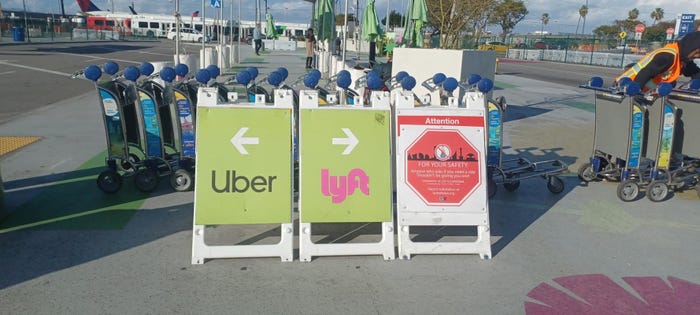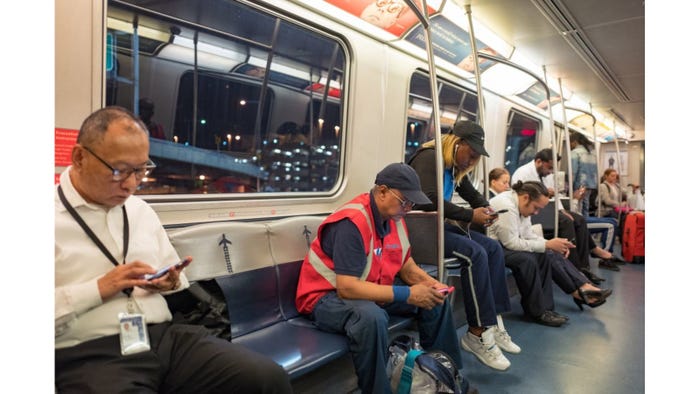Taxicabs May Not Be So Bad After All
Ridesharing may use the latest technologies but it has not made my ride any faster or easier.
.jpg?width=850&auto=webp&quality=95&format=jpg&disable=upscale)
At a Glance
- Ridesharing may be the victim of its own success, prompting stringent regulations for pick-up areas such as airports
- Ridesharing costs have also gone up due to fees and other regulations.
It has become a regular ritual for me to rant about some business or personal travel-related issue since joining Design News two years ago. I have complained more than once about the trials and tribulations of airline travel. Just few months ago, a family vacation trip was marred by a less-than-stellar experience with renting a vehicle.
This time around, I’m unloading on ridesharing, the Internet-age concept of using mobile apps to hail a car service. Many travelers now routinely use services such as Uber or Lyft to get around. This is borne out by rideshare industry statistics published last June by Zippia, which pegged the global rideshare market at $95 billion in 2022. Zippia noted that 36% of Americans now use a rideshare app, and 26% use these apps monthly. Uber was by far the most popular choice with 71% of rideshare fares.
For many years, I called local car services to get me to an airport and simply stood in line at a designated pick-up area at an airport to hail a ride home via a New York City taxi. To be sure, many vehicles I rode in were not in great shape, some cab drivers were surly, and their driving style would sometimes leave me on edge. But I always made it to my destination within a reasonable time, in one piece, and was charged fairly.
When I first started using Uber several years ago, it was a revelation to have someone pick you up within minutes after you book them on your phone. On top of that, most of the vehicles were in good shape and the drivers tended to be more courteous than regular cab drivers.
Too Much Rideshare Traffic?
But ridesharing has slowly become more of a hassle. Airports dealing with excessive traffic congestion from rideshare vehicles no longer allow them to pick up passengers directly in front of an airline terminal. I first noticed this in San Francisco two years ago when I had to walk to a designated rideshare pick-up area, but at least it was right outside the terminal, although the WiFi wasn’t too strong there.
But when I traveled to Los Angeles a year ago, I had to board a shuttle bus at LAX Airport to get to the rideshare pick-up area and spent over half an hour just to find the pick-up spot for the shuttle bus to take to the rideshare pickup area.

The rideshare pick-up area, accessible via shuttle bus only, at LAX Airport. (Spencer Chin)
If you think that is bad, see what John F. Kennedy Airport in New York City puts one through. When I returned from San Francisco on a delayed flight in the wee hours of the morning a month ago, I had to follow painted or planted footsteps (I should have taken a picture) through a long, not always well-lit, foreboding passageway to get from Terminal 4 to the airport's AirTrain tram terminal. Once there, I had to wait 10 minutes in a cold drizzle for the tram to get to the rideshare area. Mind you, the app was set up so I could not arrange for the Uber driver to come until I got to the pickup area, forcing me to wait another 10 to 15 minutes for my vehicle. Total time from deplaning to getting home: close to an hour for a 20-minute ride.

Finding the rideshare pickup area at New York City’s JFK Airport involved a long walk through a clumsily-labeled corridor and a ride on the airport’s AirTrain tram service. (Smith Collection/Gado / Contributor/ Archive Photos/Via Getty Images)
Adding insult to injury, many airports are now imposing drop-off and pick-up fees for rideshare drivers, which further inflates in many cases an already high rideshare tab.
Snafu at the Convention Center
It’s not just airports that are making it inconvenient for rideshare app users. Fast forward to the first week of February when I booked a rideshare to LAX from the Anaheim Convention Center. Yes, there is a rideshare pick-up area there, but I could not find it and there I was outside the venue in the pouring rain during a week of massive rainstorms in southern California. I wound up asking the rideshare driver to pick me up at a Clarion Hotel up the street. But as he was already in the rideshare location it took him a good 20 minutes to leave there and find me.
.jpg?width=700&auto=webp&quality=80&disable=upscale)
The Anaheim Convention Center may look state-of-the-art, but good luck trying to meet a rideshare driver there. (LordRunar/ iStock / Getty Images Plus)
This is Progress?
In many industries and walks of life, technology has enabled us to be more efficient, save time, and reduce stress in various tasks. Ridesharing, which uses modern-day technologies such as smartphones, GPS, and location finding, was supposed to be a faster and easier way than conventional taxis and car services to get from point A to B. But there’s been a backlash by local and regional authorities through increasing regulations and fees. And passengers are paying the price through escalating prices and longer delays. A ride that a year ago cost less than $60 can now cost $75 to $80 and is likely to continue rising as more fees are imposed and rates go up to cover those costs.
Meanwhile, cab services are still around, though they have lost many riders in recent years and the process of becoming a cab driver in cities like New York has become more difficult and cost-prohibitive. A generation of riders weaned on hailing rideshare vehicles is not likely to desert them for cabs anytime soon. But hopefully, it won’t be lost on others that the old-fashioned taxicab isn't such a bad way to travel.
About the Author(s)
You May Also Like





